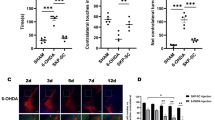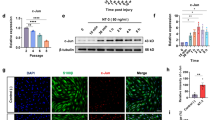Abstract
FK1706 is a novel non-immunosuppressive immunophilin ligand with neurotrophic activity and exerts its neurotrophic effect through NGF. The present study aimed to elaborate on the neurotrophic activity and the mechanism of action of FK1706 in end-to-side neurorrhaphy rats and SH-SY5Y cells. In the regenerating nerves of neurorrhaphy rats, FK1706 increased the thickness of myelin sheath and the level of nerve regeneration-related proteins. The mechanism of action of FK1706 on neurite regrowth was elucidated in vitro by incubating SH-SY5Y cells in different conditions (Control, NGF, FK1706, NGF + FK1706, NGF + FK1706 + geldanamycin). Under the conditions where NGF was used, the phosphorylation level of major proteins (Raf-1 and ERK) in the Ras/Raf/MAPK/ERK signaling pathway related to SH-SY5Y cell proliferation was significantly enhanced following the application of FK1706. The number of viable cells, cell viability and neurite length of SH-SY5Y cells was maximal when NGF and FK1706 were used simultaneously. The binding level of HSP90 and Raf-1 in FK1706 group was the highest. These results indicated that FK1706 could significantly promote nerve regeneration after neurorrhaphy. The putative mechanism of action stated that FK1706 could promote the binding of HSP90 and Raf-1, make Raf-1 continue to be activated, thereby affecting key proteins in the Ras/Raf/MAPK/ERK signaling pathway related to the neurotrophic effects of NGF to promote the proliferation and neurite regrowth of nerve cells.








Similar content being viewed by others
Data Availability
The datasets generated during and analysed during the current study are available from the corresponding author on reasonable request.
References
Yu Q, Zhang SH, Wang T, Peng F, Han D, Gu YD (2017) End-to-side neurorrhaphy repairs peripheral nerve injury: sensory nerve induces motor nerve regeneration. Neural Regen Res 12:1703–1707
Sulaiman OAR, Gordon T (2018) A rat study of the use of end-to-side peripheral nerve repair as a “babysitting” technique to reduce the deleterious effect of chronic denervation. J Neurosurg. https://doi.org/10.3171/2018.3.Jns172357
Reece JC, Dangerfield DC, Coombs CJ (2019) End-to-side somatic-to-autonomic nerve grafting to restore erectile function and improve quality of life after radical prostatectomy. Eur Urol 76:189–196. https://doi.org/10.1016/j.eururo.2019.03.036
Gao WS, Dong CJ, Li SQ, Kunwar KJ, Li B (2012) Re-innervation of the bladder through end-to-side neurorrhaphy of autonomic nerve and somatic nerve in rats. J Neurotrauma 29:1704–1713. https://doi.org/10.1089/neu.2011.2255
Gao W, Liu Q, Li S, Zhang J, Li Y (2015) End-to-side neurorrhaphy for nerve repair and function rehabilitation. J Surg Res 197:427–435. https://doi.org/10.1016/j.jss.2015.03.100
Price RD et al (2005) FK1706, a novel non-immunosuppressive immunophilin: neurotrophic activity and mechanism of action. Eur J Pharmacol 509:11–19
Voda J, Yamaji T, Gold BG (2005) Neuroimmunophilin ligands improve functional recovery and increase axonal growth after spinal cord hemisection in rats. J Neurotrauma 22:1150–1161. https://doi.org/10.1089/neu.2005.22.1150
Yamaji T, Yamazaki S, Li JY, Price RD, Matsuoka N, Mutoh S (2008) FK1706, a novel non-immunosuppressant neurophilin ligand, ameliorates motor dysfunction following spinal cord injury through its neuroregenerative action. Eur J Pharmacol 591:147–152. https://doi.org/10.1016/j.ejphar.2008.06.064
Minematsu T et al (2010) Time-Dependent Inhibitory Effects of (1R,9S,12S,13R,14S,17R,18E,21S,23S,24R,25S,27R)-1,14-Dihydroxy-12-(E)-2- (1R,3R,4R)-4-hydroxy-3-methoxycyclohexyl -1-methylvinyl-23,25-dimethoxy -13,19,21,27-tetramethyl-17-(2-oxopropyl)-11,28-dioxa-4-azatricyclo 22.3.1.0(4.9) octacos-18-ene2,3,10,16-tetrone(FK1706), a novel nonimmunosuppressive immunophilin ligand, on CYP3A4/5 activity in humans in vivo and in vitro. Drug Metab Dispos 38:249–259. https://doi.org/10.1124/dmd.109.029280
Hayashi N, Minor TX, Carrion R, Price R, Nunes L, Lue TF (2006) The effect of FK1706 on erectile function following bilateral cavernous nerve crush injury in a rat model. J Urol 176:824–829. https://doi.org/10.1016/j.juro.2006.03.071
Bella AJ, Hayashi N, Carrion RE, Price R, Lue TF (2007) FK1706 enhances the recovery of erectile function following bilateral cavernous nerve crush injury in the rat. J Sex Med 4:341–346. https://doi.org/10.1111/j.1743-6109.2007.00438.x
Kim DH, Gutin PH, Noble LJ, Nathan D, Yu JS, Nockels RP (1996) Treatment with genetically engineered fibroblasts producing NGF or BDNF can accelerate recovery from traumatic spinal cord injury in the adult rat. NeuroReport 7:2221–2225
Brown A, Ricci MJ, Weaver LC (2007) NGF mRNA is expressed in the dorsal root ganglia after spinal cord injury in the rat. Exp Neurol 205:283–286
Berthold CH, Nilsson I, Rydmark M (1983) Axon diameter and myelin sheath thickness in nerve fibres of the ventral spinal root of the seventh lumbar nerve of the adult and developing cat. J Anat 136:483–508
Stebbins CE, Russo AA, Schneider C, Rosen N, Hartl FU, Pavletich NP (1997) Crystal structure of an Hsp90-geldanamycin complex: targeting of a protein chaperone by an antitumor agent. Cell 89:239–250. https://doi.org/10.1016/s0092-8674(00)80203-2
Barbacid M (1994) The Trk family of neurotrophin receptors. J Neurobiol 25:1386–1403. https://doi.org/10.1002/neu.480251107
Gao W et al (2017) The effects of FK1706 on nerve regeneration and bladder function recovery following an end-to-side neurorrhaphy in rats. Oncotarget 8(55):94345–94357. https://doi.org/10.18632/oncotarget.21718
Skene JH, Jacobson RD, Snipes GJ, McGuire CB, Norden JJ, Freeman JA (1986) A protein induced during nerve growth (GAP-43) is a major component of growth-cone membranes. Science (New York, NY) 233:783–786. https://doi.org/10.1126/science.3738509
Liao WC, Wang YJ, Huang MC, Tseng GF (2013) Methylcobalamin facilitates collateral sprouting of donor axons and innervation of recipient muscle in end-to-side neurorrhaphy in rats. PLoS ONE 8:e76302. https://doi.org/10.1371/journal.pone.0076302
Christie KJ, Krishnan A, Martinez JA, Purdy K, Singh B, Eaton S, Zochodne D (2014) Enhancing adult nerve regeneration through the knockdown of retinoblastoma protein. Nat Commun. https://doi.org/10.1038/ncomms4670
Tanaka K, Fujita N, Higashi Y, Ogawa N (2002) Neuroprotective and antioxidant properties of FKBP-binding immunophilin ligands are independent on the FKBP12 pathway in human cells. Neurosci Lett 330:147–150
Gold BG, Densmore V, Shou W, Matzuk MM, Gordon HS (1999) Immunophilin FK506-binding protein 52 (not FK506-binding protein 12) mediates the neurotrophic action of FK506. J Pharmacol Exp Ther 289:1202–1210
Gold BG, Villafranca JE (2003) Neuroimmunophilin ligands: the development of novel neuroregenerative/ neuroprotective compounds. Curr Top Med Chem 3:1368–1375
Guy NC, Garcia YA, Cox MB (2015) Therapeutic targeting of the FKBP52 co-chaperone in steroid hormone receptor-regulated physiology and disease. Curr Mol Pharmacol 9:109–125
Toll EC, Seifalian AM, Birchall MA (2011) The role of immunophilin ligands in nerve regeneration. Regen Med 6:635–652. https://doi.org/10.2217/rme.11.43
Yamazaki S, Yamaji T, Murai N, Yamamoto H, Matsuda T, Price RD, Matsuoka N (2012) FK1706, a novel non-immunosuppressive immunophilin ligand, modifies gene expression in the dorsal root ganglia during painful diabetic neuropathy. Neurol Res 34:469–477. https://doi.org/10.1179/1743132812y.0000000029
Mitra S et al (2016) Bipartite role of heat shock protein 90 (Hsp90) keeps CRAF kinase poised for activation. J Biol Chem 291(47):24579–24593. https://doi.org/10.1074/jbc.M116.746420
Soderholm H, Olsson AK, Lavenius E, Ronnstrand L, Nanberg E (2001) Activation of Ras, Raf-1 and protein kinase C in differentiating human neuroblastoma cells after treatment with phorbolester and NGF. Cell Signal 13:95–104
Shen JH (2004) Preliminary study on apoptosis and differentiation of human neuroblastoma SH-SY5Y cells. Dissertation, Peking Union Medical College. [in Chinese]
Zhao YS (2011) Role of Hsp90/Raf-1 and ERK pathways in apoptosis of elemene-induced glioma cells. Dissertation, Dalian Medical University. [in Chinese]
Zgajnar NR, De Leo SA, Lotufo CM, Erlejman AG, Piwien-Pilipuk G, Galigniana MD (2019) Biological actions of the Hsp90-binding immunophilins FKBP51 and FKBP52. Biomolecules 9:30. https://doi.org/10.3390/biom9020052
Zhou YY, Wang HY, Tang ZG, Ma DL (1984) Two new formulae for evaluating effectiveness of drug combinations and revision of Burgi’s and Jin’s modified Burgi’s formula. Zhongguo Yao Li Xue Bao 5:217–221
Sasaki K, Yasuda H, Onodera K (1979) Growth inhibition of virus transformed cells in vitro and antitumor activity in vivo of geldanamycin and its derivatives. J Antibiot 32(8):849–851. https://doi.org/10.7164/antibiotics.32.849
Park KK et al (2008) Promoting axon regeneration in the adult CNS by modulation of the PTEN/mTOR pathway. Science 322:963–966. https://doi.org/10.1126/science.1161566
Zhang E, Chen Q, Wang J, Li D, Wan Z, Ju X (2020) Protective role of microRNA-27a upregulation and HSP90 silencing against cerebral ischemia-reperfusion injury in rats by activating PI3K/AKT/mTOR signaling pathway. Int Immunopharmacol 86:106635. https://doi.org/10.1016/j.intimp.2020.106635
Mange A et al (2019) FKBP4 connects mTORC2 and PI3K to activate the PDK1/Akt-dependent cell proliferation signaling in breast cancer. Theranostics 9:7003–7015
Laplante M, Sabatini DM (2013) Regulation of mTORC1 and its impact on gene expression at a glance. J Cell Sci 126:1713–1719. https://doi.org/10.1242/jcs.125773
Acknowledgements
We are grateful to be supported by the members of pediatric surgical pelvic floor functional reconstruction team led by professor Jianguo Wen, the First Affiliated Hospital of Zhengzhou University; Team No. SZSM201612013.
Funding
This study was funded by the National Natural Science Foundation of China [Grant Numbers 81400689, 81670689].
Author information
Authors and Affiliations
Contributions
WG is the group director and main designer of this research project who planed and supervised the research and played a substantial role in editing the manuscript. HY prepared all the data in suitable format for manuscript and wrote the preliminary manuscript. LX cultured the SH-SY5Y cells and performed the molecular assessment in the research. WH performed the surgical procedures in rats and finished the morphological study in the molecular assessment. YY helped finished the molecular assessment, performed the Co-IP and analyzed the quantitative results. All authors have read and approved the final manuscript.
Corresponding author
Ethics declarations
Conflict of interest
The authors have no relevant financial or non-financial interests to disclose.
Ethical Approval
This study was performed in line with the principles of the Declaration of Helsinki. This study was approved by the Ethics Committee of the First Affiliated Hospital of Zhengzhou University (Ethical Approval Number: 2014-1282).
Additional information
Publisher's Note
Springer Nature remains neutral with regard to jurisdictional claims in published maps and institutional affiliations.
Supplementary Information
Rights and permissions
About this article
Cite this article
Gao, W., Yang, H., Xu, L. et al. The Neurotrophic Effects and Mechanism of Action for FK1706 in Neurorrhaphy Rat Models and SH-SY5Y Cells. Neurochem Res 46, 2897–2908 (2021). https://doi.org/10.1007/s11064-021-03391-1
Received:
Revised:
Accepted:
Published:
Issue Date:
DOI: https://doi.org/10.1007/s11064-021-03391-1





